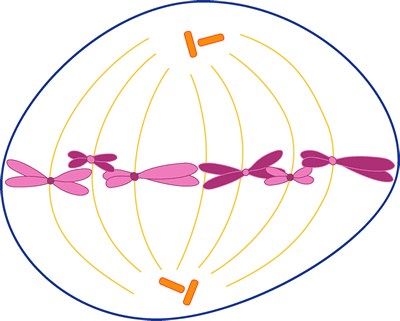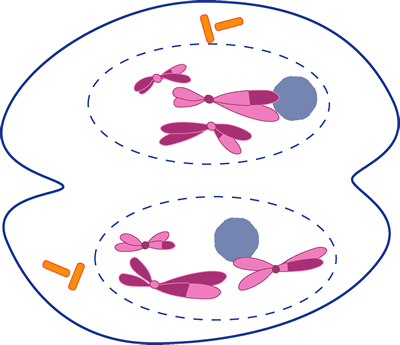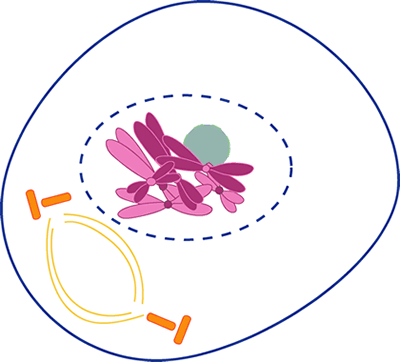What is Cloning?
1. Who is Dolly? Dolly was a sheep that was an exact genetic replica of the adult female sheep that donated the somatic cell nucleus to the egg. She was the first-ever mammal to be cloned from an adult somatic cell.
2. When a zygote divides into two separate cells, it is called: Twinning
3. Somatic cells are also called Diploid cells
4. In order to clone a gene, a gene is inserted into a plasmid
5. In order to create an embryo from a somatic cell, the donor egg cell must have its nucleus removed.
Click and Clone
6. List all the materials needed to clone a mouse.
Mouse to clone, an egg cell donor, a surrogate mother (to raise the mouse clone), petri dishes, a microscope, a sharp and blunt pipette, and a chemical ignite cell division.
7. Place the following steps in the correct order.
4.Stimulate cell division
6. Deliver baby
2. Remove and discard the nucleus from the egg cell
1. Isolate donor cells from egg donor and germ cell donor
3. Transfer the somatic cell nucleus into the egg cell
5. Implant embryo into a surrogate mother
8. There are two time gaps in the process of cloning. What are they? (ie. what do you have to wait for?) You have to wait for the DNA and egg cell to adjust (the DNA needs to "reboot") and the cells to divide and also for the baby to develop.
9. What color with the cloned mouse be? brown What is the name of this mouse?Mini-Mimi
Why Clone?
10. Why is cloning extinct animals problematic?
It's not likely that dinosaur DNA could survive undamaged for such a long time. However, scientists have tried to clone species that became extinct more recently, using DNA from well-preserved tissue samples and the clone may not live longer due to the risk of getting a disease of bacteria.
11. What are some reasons a person might want to clone a human?
To replace a loved one that was killed in a war or accident of some sort.
The Clone Zone
12. What animal was cloned in 1885?a sea urchin
13. How did Spemann separate the two cells of the embryo of a salamander in 1902? Spemann created a miniature noose with a baby's hair.
14. The process of removing a nucleus is called Enucleation.
15. In 1952, the nucleus of a frog embryo cell was placed into a donor cell. Did it work to clone the animal? no and the few that had worked grew abnormally.
16. Can the nucleus of an adult cell be injected into an egg cell and produce a clone? yes this happened in 1968 successfully with frogs.
17. Why are mammals hard to clone? Mammals egg cells are much smaller than frogs or salamanders therefore making the process harder to manipulate.
18. What were the names of the first two cloned cows?The first two cloned calves were named Fusion and Copy!
19. In what year was the National Bioethics Advisory Council formed? In 1995 this council was formed.
20. The first mammal clone to be produced from an adult (somatic) cell? Dolley the Sheep!
21. What do scientists do to adult cells to make them "behave" like embryos? they reboot the cells by using the technique of electric shock.
22. Transgenic, cloned sheep were used to produce what medical protein?Factor nine is the protein and can be used to treat people with hemophilia.
23. What is a stem cell? stem cells are cells found in most multi-cellular organisms.
Cloning Myths
24. Briefly describe in your own words, why CC the cat was not identical in color to Rainbow, even though she was a clone/. On Chromosome X there is gene that determines what color the coat is. Since the two cats have the exact same X chromosomes, they have the same two coat color genes, one specifying black and the other specifying orange.
25. What is "nature vs nurture"?
Genetics can help determine traits, environmental influences have an impact on shaping the physical appearance and personality of a person. An example would be with twins that they are twins but they don't act and think alike.
Is it Cloning or Not?
26. For each of the following scenarios, indicate YES (it is cloning) or NO (it is not cloning)
NO Sperm taken from a mole goat is combined with a female's egg in a petri dish. The resulting embryo is implanted into the female's uterus to develop
YES A sheep embryo, composed of 16 cells, is removed from the mother's uterus and separated into indivudal cells. Each cell is allowed to multiply, creating 16 separate embryos, which are then implanted in different female sheep to develop to maturity.
NO A cow with many desirable traits is stimulated with hormones to produce a number of egg cells. Each of these eggs is fertilized and implanted into a surrogate mother.
NO In vitro fertilization
YES Cell nuclei from an extinct wolly mammoth are placed into enucleated cow cells.
27. Define or describe each of the following processes (you may need to reset the Cloning or Not Screen)
Invitro fertilization-is a process by which egg cells are fertilized by sperm outside of the body.
Embryo splitting- the natural way in which twins produced.
Somatic Cell Nuclear Transfer- is a technique used for embryonic stem cell research.
Multiple Ovulation Embryo Transfer- a way of producing an animal with certain genetic qualities faster.
Artificial Insemination- is the process by which sperm is placed into the reproductive tract of a female for the purpose of impregnating the female, " an artificial way and not naturally."
What Are the Risks of Cloning?
28. What is one reason why cloning animals has such a high failure rate?
The reasons are the enucleated egg and the transferred nucleus may not be compatible, an egg with a newly transferred nucleus may not begin to divide or develop properly, implantation of the embryo into the surrogate mother might fail, and the pregnancy itself might fail. There are so many factors that need to go perfectly for the cloning to be successful, and yet if one step doesn't work the whole process is not going to work.
29. What is a telomere and how does it affect cloned animals?
As cells divide, chromosomes get even shorter. This affects the cloned animals by these cells showed other signs of youth and seemed to have an extended lifespan compared with cells from a naturally conceived cow.
What Are Some Issues in Cloning?
30. Pick one of the questions to ponder and ....ponder it. Write a brief essay on your thoughts and opinions. Is human cloning "playing with nature?" If so, how does that compare with other reproductive technologies such as in vitro fertilization or hormone treatments?
Human Cloning or "Playing With Nature"?
Human cloning is playing with nature and it is not something that should be done. The treatments that are like reproductive technologies such as in vitro fertilization or hormone treatments are okay because they are totally different from what the intentions are. If you have tried to have kids and then you went to the treatments that is fine, but if you go to get one of your kids cloned when you can have kids that is just being selfish.
Cloning for most reasons is just to be selfish. When a loved one is deceased and you would want to have a clone of them. I understand this. If I was in this position, I would understand how hard it is when this is the situation. This is still right intentions. When you are cloning because you have a sick child that needs 100% compatibility for organ transplants like in the movie My Sister's Keeper this happens and the other child is so sick that the other child was made to basically give her sister her parts so that she can live. This is not the right intentions. Another example, when a married couple can't have children then it is not selfish to do the treatments and cloning. This is still the right intentions.
Cloning is playing with nature because we were made individually and there is no one exactly like you. Cloning is going against everything on genetics. If it is going against nature so much why do it? People are only doing this either for good reason or for selfish reason. New technology is coming out everyday for the world of genetics we need to have more responsibility.








